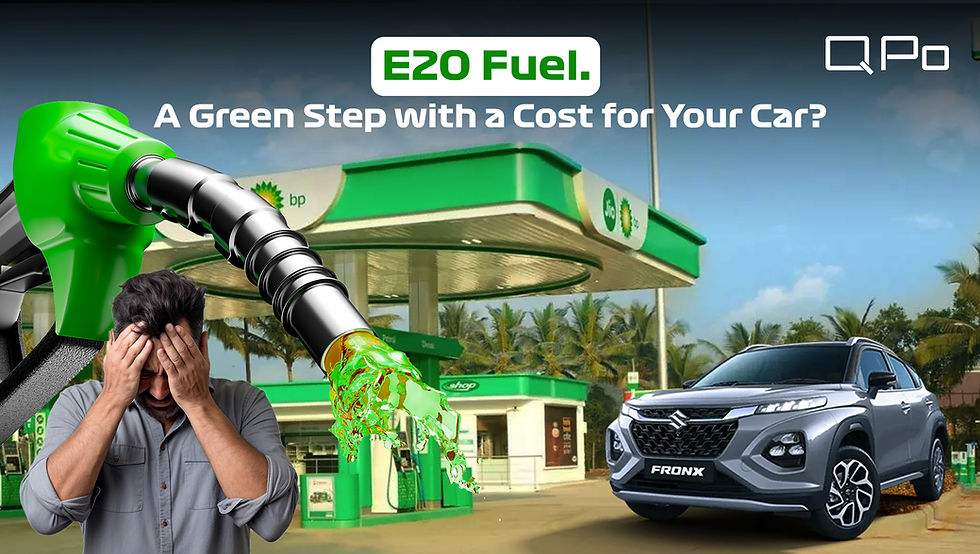E20 Fuel: A Green Step with a Cost for Your Car?
- Q Po India
- 6 days ago
- 3 min read

India just flexed big on the green energy scoreboard – we hit 20% ethanol blending in petrol (E20) five years ahead of schedule!
High five for the planet? Absolutely.
High fives from your car? Well… that depends.
While the headlines are all about eco-friendliness and Atmanirbhar Bharat, many car owners are quietly scratching their heads, "Why does my mileage feel like it’s going on a diet?"
Mileage Drops & Wallet Pops

Here’s the not-so-fuel-efficient truth:
Ethanol has less energy than petrol. So when you fill up with E20, your car might be burning through it faster – especially if it's not designed for it.
Result?
Mileage could drop by 3–6%, meaning more pit stops and a lighter wallet.
If you're driving a car made before April 2023, chances are it's only built for E10, not E20.
And this ethanol party could be too wild for your engine to handle.
Is Your Car E20 Ready?

Cars built after April 2023 are the cool kids at the ethanol party – ethanol-resistant parts, smarter ECUs, and all. But older cars? Not so much.
However, the vast majority of India's vehicle fleet, including BS6 cars sold between 2020 and 2023, are only E10 compliant. Using E20 in these older cars can lead to a host of problems:
* Rust & Leaks: Ethanol attracts water (it’s hygroscopic – science flex!), which can rust fuel systems and eat away at plastic and rubber parts like a midnight snack.
* Engine Knocking: That annoying knocking sound? It’s not your car applauding the environment – it’s a bad sign. Think premature combustion and long-term engine trouble.
* Cold-Start Drama: Winter mornings just got worse. Ethanol-blended fuels can make starting your car even tougher when it’s chilly.
Coming Soon: E27 – The Sequel No One Asked For Yet

Just when you were figuring out E20, bam, E27 is already revving in the background. The government plans to blend 27% ethanol, and agencies like ARAI and BIS are working overtime to make it happen.
Even more futuristic? Draft rules for E100 vehicles (100% ethanol-powered) are out. And there's talk of using isobutanol in diesel engines.
Exciting? Yes .
Complicated? Also, yes.
Transparent? Umm… we’ll get back to you on that.
We’re not saying it’s bad. We’re just saying it’s classic jugaad governance – implement first, worry about side effects later.
Fuel Station: Temple of Confusion

You’d expect petrol pumps to inform you clearly about what they’re dispensing, right?
Welcome to India, where transparency is an optional feature.
Expect vague signage, confused attendants, and the eternal shrug:
"Sir, sab same hi hota hai."
But don’t worry. If your engine dies, the government might just suggest buying a new car.
Preferably one that’s E27-compatible and manufactured by their Make in India buddies.
So, What Can You Do (Besides Cry)?

* Ask: Is your car E20-compatible? If it’s made before April 2023, chances are it’s not.
* Inquire at Pumps: Don’t assume. Ask what blend they’re serving. (Yes, it’s awkward. But so is engine failure.)
* Keep Receipts: In case your car throws a fit, at least you’ll know where the betrayal started.
Great Policy, Horrible Rollout – As Usual
“We blended ethanol to save the planet.”
“We ignored vehicle compatibility.”
“We kept petrol prices high anyway.”
“Now clap.”
So next time you're at a fuel station, smile as you pay ₹100+ per litre for 20% cheaper ethanol-blended fuel that might slowly kill your car.
Because of that, my friend, that is what they call progress.



Comments